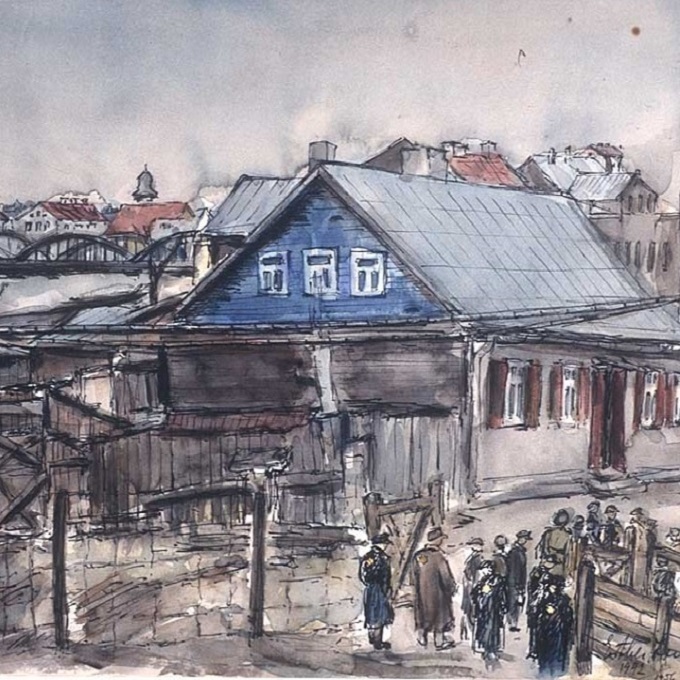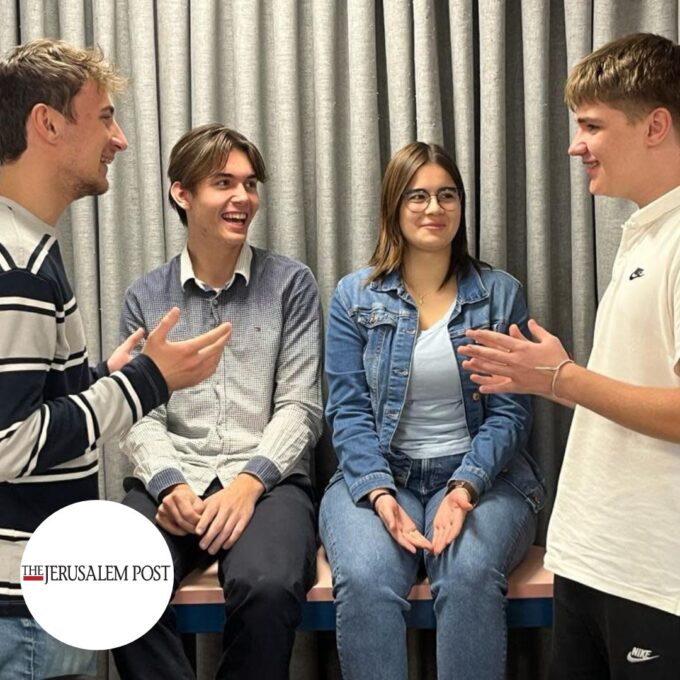In this article, Elda Schwartz looks at the life of her mother, Rose Norwich, who marked her 100th birthday in 2021 and who has been a supporter of ORT’s work in South Africa for almost 80 years:
Rose Norwich, my mother, recently celebrated her 100th birthday. Where I live in the United States, around one in 5,000 people reach that age and become a centenarian.
Everyone who knows Rose is struck by her energy, intellect, sense of humor and is assured of an interesting conversation with her.
Due to the Covid-19 pandemic, we were not able to celebrate this special birthday all together as a family. Instead we arranged a series of successful Zoom calls with family and friends, from far and wide.
It was on one of these Zoom calls that I realized that not everyone had heard of ORT or ORT South Africa. This gave me pause and led to the realization that, while growing up in Johannesburg, ORT had been a household name for me. It led me to think back and research how my mother became involved with the organization, the impact she had on ORT, the people with whom she worked, and how in turn it influenced me.
The birth of World ORT dates back to Czarist Russia. South Africa ORT-OZE was formed in 1937. The “OZE” was dropped and became ORT SA, the Organization for Rehabilitation through Training in South Africa. It was initially an agency by and for Jewish people, providing training in needed industrial skills and crafts to assure a life of economic security and dignity.
Founding of ORT South Africa
Rose told me that her father, Abraham Sive, was one of the founding members of ORT-OZE in Johannesburg and that she too, grew up knowing the organization as a household name.

Rose at an ORT banquet in South Africa in 1939. She is seated front right.
In the 1960s, when my three siblings and I were older and Rose no longer worked as an architect, she was ready to take on significant activities.
In 1966, Robin Gilbert, Secretary of World ORT from the Geneva, Switzerland, head office, visited South Africa to recruit a new ORT committee. At that time the ORT leadership in South Africa was older and retiring. Robin was often a guest at our house and we enjoyed our time together.
He recruited Rose, Richard Goldstone and Basil Wunsh. They worked together to resurrect the organization and see it grow. Richard and Basil alternated as chairmen of ORT South Africa. Richard was then put onto the Executive Committee of World ORT and maintained the role, becoming President of World ORT.
Rose reminisced that she would meet Richard and Basil over lunch in the Fox Street ORT office in Johannesburg. Rose told me she at first did a lot of work to organize and track the membership and other administrative tasks. Judge Richard Goldstone said recently: “Rose gave good advice, she was positive and proactive, a stalwart of ORT South Africa. Basil and I benefitted from her sage council when we worked together.”
A decision was made to separate a Women’s ORT group to make it a self-funding entity. Rose headed up the first Johannesburg Women’s ORT. In addition to the Johannesburg branches of Women’s ORT, two of which were named the Bramson and Syngalowski branches after famous ORT leaders, other branches were formed around the country, in Durban, Cape Town, Port Elizabeth, Pretoria and Bloemfontein.
The scope of support provided by Women’s ORT grew: raising funds to furnish the Jewish Girls School in Tehran, for a hearing-impaired school in Tel Aviv and for the Max Braude School in Israel.
Rose planned the physical move of the women’s group out of the downtown area to an office off Louis Botha Avenue, then to a house in Norwood. At the present time ORT SA is located in ORT House, in Houghton, Johannesburg.
For Rose, one of her most satisfying roles was to train incoming committee members. She said training had not been done before but would help newcomers know the “lay-of the-land” – how to do the minutes, how to write a report, how to speak in front of others and generally what to do. Her mentoring benefitted the women tremendously and they felt it was very helpful in taking on their own roles in the ORT organization.
Rose was head of Women’s ORT when World ORT turned 100 in 1980.
Amongst the fundraising activities Rose initiated alongside my father, Oscar, were four international graphic art exhibitions. The last exhibition was for the Johannesburg Women’s ORT Centenary Exhibition of International Graphics. It was held at the Total Gallery in Braamfontein on April 25, 1980.
My father, knowledgeable about art, had lithographs and etchings sent, in poster tubes, from respected art galleries in London. The artists were world-renowned and included names such as Marc Chagall, Henry Moore, Jim Dine, and the Israeli Yaakov Agam. My parents became the “doyennes of the art world” and helped to cultivate an art experience for many people.
The Director of the Pretoria Art Museum authenticated and opened the first exhibition. He was so impressed that he bought works for the museum. Not only were these exhibits hugely successful but they elevated the name of ORT in Johannesburg.
Another function that drew women together in Johannesburg was “The Women of our Time” luncheon that put ORT on the social events map. Louise Tager, professor and sometime Dean at Wits University School of Law chaired the organizing committee. Helen Suzman, anti-apartheid activist and politician, attended as did members of the diplomatic corps. There was a lot of publicity putting ORT in the limelight.
ORT’s history points to the organization being able to pivot, adjusting and changing its approach to help people become financially independent. Depending on the social, economic and political situations of the times and the countries the organization worked in, ORT adjusted.
From 1936 to 1994 ORT South Africa worked purely as a fundraising entity for causes outside the country. With the release of Nelson Mandela and with the apartheid system being dismantled, in 1994 ORT became a non-racial, inclusive, multi-faceted operational organization. With high unemployment, the need existed within South Africa to help its own people. The organization implemented vocational and training programs to develop teachers, benefit students, aid small business to better communities and to improve the standard of education so that all could achieve a better life.
Dorienne Levitt, a previous National Chairman of ORT SA, reminisced how she and Rose spent a great deal of time with the archives, sorting and sifting the history of the organization. She and Rose worked tirelessly on hundreds and hundreds of photos that were boxed in the ORT House cupboards. They sent exceptional articles and photographs to World ORT but anything relevant to ORT SA was saved.
Dorienne said: “When given books to read about ORT, Rose would discuss these with me over tea. I learned so much about how to look after the history of our organization.”
In those archives would be the documentary that Rose made with film-maker Lee Marcus, “The Weft”, a slideshow about the history of ORT.
All this sounds very much like Rose – having good company and with her attention to detail, organizing, and removing the unimportant. Amongst her other projects that required huge amounts of research and planning was the Museum of the Jewish People Beit Hatfutsot Exhibition about the Jews of South Africa in Tel Aviv in 1983; her Masters dissertation in 1988 at Wits University on the “Synagogues of the Witwatersrand and in Pretoria before 1932 – Their Origin, Form and Function”, volumes one and two; and later the volumes of “Jewish Life in the South African Country Communities” that she headed up with others for so many years.
80 years of service
At 100, Rose is still up-to-date with things that are happening with ORT. When World ORT celebrated its 140th anniversary in 2020, she sent her children the video link to commemorate that and has talked about how ORT is doing so many new things.
For example, in South Africa ORT JET works and assists small business owners in the Jewish and outreach communities; academies such as the STEM Academy support schools in previously disadvantaged communities with Math, Science, IT and coding programs; ORT SA works closely with the department of education aiming at uplifting the state of education in the country; the Skills Academy places unemployed youth in quality work experience and trains them with relevant skills to be employable; and the IT Academy provides computer and digital skills to equip youth for the changing world of work.

Rose featured in a Hewlett Packard advert with ORT SA students
World ORT and ORT SA have also become affiliated under the umbrella of the South African Board of Jewish Education to the King David Schools in Johannesburg.
There is a common thread with ORT in my own background. I lived in Geneva for a year in 1970, post matric, where the ORT head office was located before it moved to London. An important contact for me was Vladimir Halperin’s family. I recently learned that Vladimir was a direct descendent of one of the three ORT founders, Baron Horace de Gunzberg, back in the 1880s in Russia.
My professional background as a Career Counsellor was in educational settings. I advised and taught American and international students to plan their degree curricula and aided in career decisions. With a US-accredited national program, I helped to certify educators, who had no previous career background and wanted to enhance their credentials.
Ariellah Rosenberg, current CEO of ORT SA, said this to me about Rose’s 100th birthday: “As you can see, the tributes on the beautiful birthday card are testimony of the impact your mother has had on people throughout her time serving on the Board of ORT. Rose is an honorary life president of ORT SA. Her wisdom, insight, and critical perspective have been instrumental in the direction of the organization and the legacy she has created.”
ORT was a place for my mother to be a leader, share her intellect, her belief in education for everyone, her sense of justice and humanity for the downtrodden, and to make a difference. It also went along with the values that my parents held, with the emphasis on education, a focus on helping others, the international nature of serving other Jewish communities, and now within South Africa. It provided a life of service.
Talking with Rose, she becomes animated about ORT, the people she worked with and the things they did. I asked her: “When did you leave ORT for the Union of Jewish Women?” Her reply was: “I have really never left ORT.”
ORT has run through two generations of my family. I hope to be able to continue in some way to do the same for the next generation.





